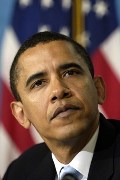Yet Another Reason Not to Fileshare
 At least, if you work at a government contractor: Iranian hackers may download those super-secret plans for Marine One that you are working on.
At least, if you work at a government contractor: Iranian hackers may download those super-secret plans for Marine One that you are working on.
 At least, if you work at a government contractor: Iranian hackers may download those super-secret plans for Marine One that you are working on.
At least, if you work at a government contractor: Iranian hackers may download those super-secret plans for Marine One that you are working on.

 (This is the fourth in a series of posts on Fairey v. Associated Press. See below for other posts in the series.)
(This is the fourth in a series of posts on Fairey v. Associated Press. See below for other posts in the series.)
There are two intriguing mysteries in the Shepard Fairey case related to how the Obama Hope poster (above right) was created. First, while Fairey’s poster looks pretty similar to Mannie Garcia’s photograph at left, Fairey actually claims he based his poster on a very different photograph, albeit one taken at the same event, with Obama looking in the same direction. Second, the complaint is fairly cagey about the actual creation process behind the poster. In particular, it’s not clear from the complaint whether Fairey simply photoshopped the Garcia photo, or rather created the poster by hand.
Why do either of these things matter? The first issue matters doctrinally; the amount of the copyrighted work that was taken helps to determine both infringement liability and counts in evaluating any fair use defense. The second issue matters more atmospherically; it just seems easier to credit a claim of substantial similarity, or conversely harder to credit a claim of fair use, if Fairey copied the original and altered it down, rather than creating a similar-looking version from the bottom up. I’d venture that that may be true even if the two processes led to exactly the same end product, although that might not make much sense as a theoretical matter.
So what’s the truth? Which image did Fairey use, and what did he do to it?
 According to this breathless story on CNET, sinister congressional forces are afoot attempting to impose a record-keeping requirement on home networks. But as I warn my Internet Law students every year, you just can’t rely on CNET posts on legislative developments, particularly the more sensational the headline. And that turns out to be true here as well. I doubt anyone in Congress actually intends to require home network users to maintain visitor logs. If that unexpected result does come about, it’s because Congress and the courts are miscommunicating. There’s a deeper problem with the relevant statutory language here, but it’s one that’s been around for a while.
According to this breathless story on CNET, sinister congressional forces are afoot attempting to impose a record-keeping requirement on home networks. But as I warn my Internet Law students every year, you just can’t rely on CNET posts on legislative developments, particularly the more sensational the headline. And that turns out to be true here as well. I doubt anyone in Congress actually intends to require home network users to maintain visitor logs. If that unexpected result does come about, it’s because Congress and the courts are miscommunicating. There’s a deeper problem with the relevant statutory language here, but it’s one that’s been around for a while.
Here’s the situation: wrongdoing on the Internet is often difficult to track down, because often the only reliable traces a malfeaser leaves behind is their computer’s IP address. It’s a bit like having someone’s phone number show up on caller ID. But unlike phone numbers, IP addresses often change. If the phone company didn’t keep any track of who had what phone numbers, the police or victims of harassment wouldn’t have any way of using the number to track the perpetrator down. It’s the same with IP addresses. Usually internet access providers keep track of who they assign IP addresses to, but there’s no requirement that they do so. There’s also no requirement that they keep such information for any particular length of time—it’s purely up to them, and storing data costs money, so ISPs purge their logs on a regular basis. So suppose a kidnapper logs into Gmail and sends an email with a ransom demand to the victim’s family. If Google chooses not to keep any access logs, there may be no way for the police to track the kidnapper down, even if the kidnapper took no steps to cover his or her tracks.
Enter the Internet SAFETY Act, yet another in the long line of recent Congressional bills with cutesy acronyms.